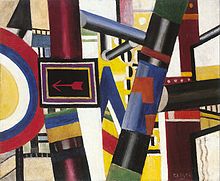Tubism
Appearance

Tubismis a term coined by the art criticLouis Vauxcellesin1911to describe the style of French artistFernand Léger.[1]Meant as derision, the term was inspired by Léger's idiosyncratic version ofcubism,in which he emphasizedcylindricalshapes. The style was developed by Léger in his paintings of 1909–1919, such asNudes in the Forest(1909–10) andSoldiers Playing Cards(1917).[2]
References
[edit]Bibliography
[edit]- Néret, Gilles (1993).F. Léger.New York: BDD Illustrated Books.ISBN0-7924-5848-6
- Buck, Robert T., et al. (1982).Fernand Léger.New York: Abbeville.ISBN0-89659-254-5
